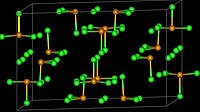Tellurium tetrachloride
 |
|
| Names | |
|---|---|
|
IUPAC names
Tellurium(IV) chloride
Tetratellurium hexadecachloride |
|
| Other names
Tellurium chloride
|
|
| Identifiers | |
|
3D model (JSmol)
|
|
| ChemSpider | |
| ECHA InfoCard | 100.030.038 |
|
PubChem CID
|
|
| UNII | |
|
|
|
|
| Properties | |
| [TeCl4]4 | |
| Molar mass | 1077.64 g/mol |
| Appearance |
hygroscopic pale yellow solid (if fused, maroon liquid) |
| Density | 3.26 g/cm3, solid |
| Melting point | 224 °C (435 °F; 497 K) |
| Boiling point | 380 °C (716 °F; 653 K) |
| Structure | |
| Monoclinic, mS80 | |
| C12/c1, No. 15 | |
| Distorted octahedral (Te) | |
| Seesaw (gas phase) | |
| 2.59 D (gas phase) | |
| Hazards | |
| Main hazards | Toxic, corrosive, respiratory irritant |
| Related compounds | |
|
Other anions
|
Tellurium tetrafluoride Tellurium tetrabromide Tellurium tetraiodide |
|
Other cations
|
Selenium tetrachloride Polonium tetrachloride |
|
Related compounds
|
Tellurium dichloride |
|
Except where otherwise noted, data are given for materials in their standard state (at 25 °C [77 °F], 100 kPa).
|
|
|
|
|
| Infobox references | |
Tellurium tetrachloride is the inorganic compound with the empirical formula TeCl4. The compound is volatile, subliming at 200 °C at 0.1 mm Hg. Molten TeCl4 is ionic, dissociating into ions TeCl3+ and Te2Cl102−.
TeCl4 is monomeric in the gas phase, with a structure similar to that of SF4. In the solid state, it is a tetrameric cubane-like cluster, Te4Cl16. The cluster with a Te4Cl4 core and three terminal chloride ligands for each Te. Alternatively it can be considered as a Te4 tetrahedron with face-capping chlorines and three terminal chlorines per tellurium atom, giving each tellurium atom a distorted octahedral environment
TeCl4 is prepared by chlorination of tellurium powder:
The reaction is initiated with heat. The product is isolated by distillation.
TeCl4 has proven of occasional interest in organic synthesis. It adds to alkenes to give Cl-C-C-TeCl3 derivatives, wherein the Te can be subsequently removed with sodium sulfide. Electron-rich arenes react to give aryl Te compounds. Thus anisole give TeCl2(C6H4OMe)2, which can be reduced to the diaryl telluride.
...
Wikipedia


